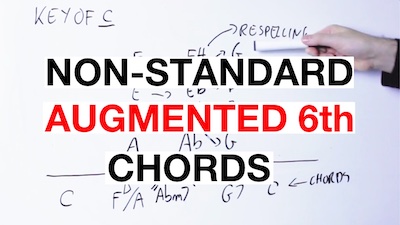ADVANCED Augmented 6th Chords: Beyond The Italian, German, French Chords


I am an openly nerdy man.
And - you may have noticed - one of the things I like to nerd about is music theory
(Yes, I just used “nerd” as a verb. Deal with it)
As a true nerd, I get very particular on what I like to nerd about. For instance I have very very very little patience with ‘theory for the sake of theory’.
I don’t see any point in pages and pages of pseudo-mathematics that do not help you or me making actual music.
And I’m not interested in copying the same 3-4 examples that I can find in music theory books either.
What I like is to understand “why” music theory works…
… get to the “ideas” behind it…
… then use these ideas to create new sounds and chords and melodies.
If you write your own music - or you want to go beyond the simple ‘3 pop chords’ that are so common today - this is what you want too.
Not just the 3 basic examples. Not the pseudo math. Just ideas that you can use and adapt as you want.
Today we see one of these ideas - and how to create new chords with it.
Yes, music theory books give you only the same 3 examples for this idea. We are going to go well beyond that… so here’s some new ‘hip’ chords for ya:
If this video is wayyyyy to advanced for you… it’s because you want to start from the beginning of the series:
And if you are wondering how people can make music “with ideas so complex that you need a doctorate to use them” (actual quote from a comment)… well, that’s because these ideas are really NOT that complex if you learn music theory in the right way!
I mean, if you learned music theory from 10.000 different online articles, YouTube videos, books etc… then yes, YES, these concepts are difficult.
But if you learn music theory in an INTEGRATED way, then it’s not really that hard.
How can you learn music theory in an integrated way? Why, if you are a guitar player, look no further than the Complete Chord Mastery guitar course, designed to give you absolute command of harmony on guitar.
Did you find this video helpful? Do not miss the next Music Theory videos!
Subscribe to the MusicTheoryForGuitar YouTube channel by clicking the button below.